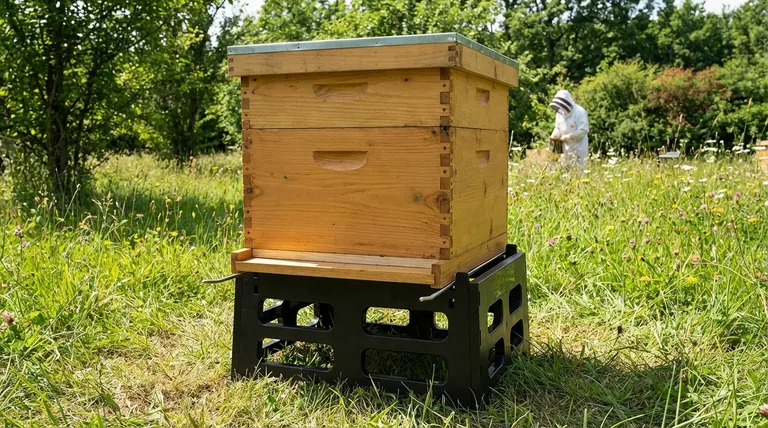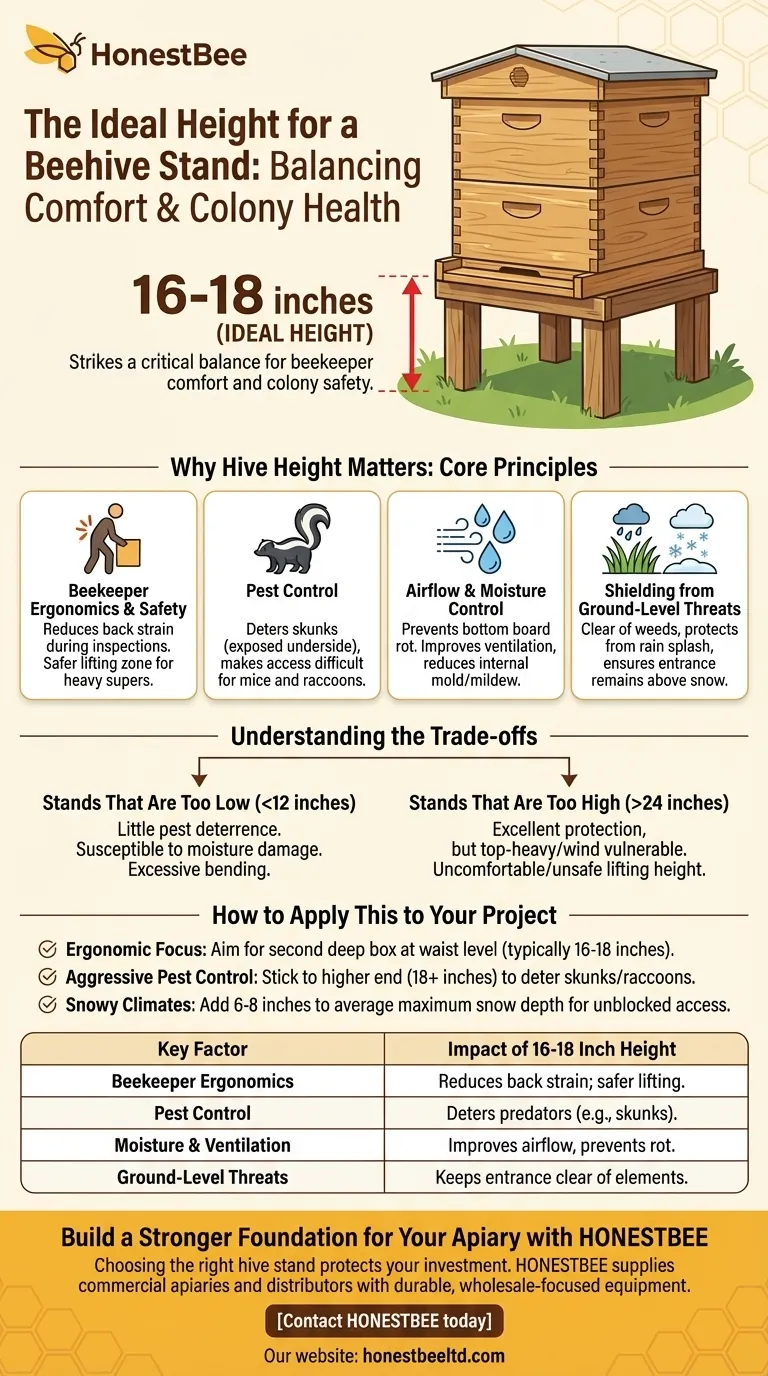The ideal height for a beehive stand is a base that places the hive's bottom entrance between 16 and 18 inches off the ground. This specific range is widely recommended because it strikes a critical balance between the comfort of the beekeeper and the health and safety of the bee colony.
Choosing a hive stand height is not just about convenience; it's a strategic decision that directly impacts pest control, moisture management, and your own physical well-being while managing the hive. The 16-18 inch rule is a proven starting point, but understanding the principles behind it is key.

Why Hive Height Matters: The Core Principles
A hive stand does more than just keep your equipment out of the mud. Its height is a foundational element of Integrated Pest Management (IPM) and good beekeeping ergonomics.
Beekeeper Ergonomics and Safety
A stand at 16-18 inches places the hive's lower boxes at a comfortable height for inspection, reducing the need to bend over completely. More importantly, it positions heavy honey supers (which can weigh 50+ lbs) in a safer lifting zone, minimizing back strain during harvest.
Protecting the Hive from Pests
Elevation is your first line of defense. Skunks, a common hive predator, must stand on their hind legs to reach an entrance 18 inches high, exposing their vulnerable underbelly to guard bee stings. This height also makes access more difficult for pests like mice, possums, and raccoons.
Improving Airflow and Moisture Control
Lifting a hive off the damp ground is crucial for colony health. It prevents the bottom board from absorbing moisture and rotting, and it dramatically improves air circulation. Good ventilation helps the bees manage humidity and prevents mold and mildew inside the hive, especially during winter.
Shielding from Ground-Level Threats
A proper stand keeps the hive entrance clear of overgrown grass and weeds, which can obstruct foraging bees and provide cover for pests. It also protects the hive from ground-level water during heavy rains and ensures the entrance stays above typical snow depths in winter climates.
Understanding the Trade-offs
While 16-18 inches is the standard recommendation, deviating from it comes with specific consequences. Understanding these trade-offs ensures you make an informed decision.
The Problem with Stands That Are Too Low
A stand below 12 inches significantly reduces the benefits. It offers little deterrence to skunks, is more susceptible to moisture damage from rain splash-back, and requires excessive bending, which can make beekeeping a physically taxing chore.
The Challenge of Stands That Are Too High
Exceeding 24 inches can create new problems. While it offers excellent pest and moisture protection, it can make the hive top-heavy and more vulnerable to being knocked over by strong winds. Crucially, it forces you to lift heavy honey supers to an uncomfortable and potentially unsafe height.
How to Apply This to Your Project
The standard recommendation is an excellent guideline, but you should adjust it based on your specific environment and physical needs.
- If your primary focus is ergonomic comfort: Aim for a height where the hive's second deep box (the top of the main brood chamber) sits roughly at your waist level. For most people, a 16-18 inch stand achieves this perfectly.
- If your primary focus is aggressive pest control: Stick to the higher end of the range, ensuring the hive entrance is at least 18 inches off the ground to deter skunks and raccoons effectively.
- If you live in a snowy climate: Determine your average maximum snow depth and add 6-8 inches to it. This ensures the hive entrance remains unblocked throughout the winter, which is critical for ventilation and cleansing flights.
Ultimately, the right hive stand serves both the bees and the beekeeper, creating a stable foundation for a healthy and productive colony.
Summary Table:
| Key Factor | Impact of 16-18 Inch Height |
|---|---|
| Beekeeper Ergonomics | Reduces back strain; positions heavy supers in a safer lifting zone. |
| Pest Control (e.g., Skunks) | Deters predators by forcing them to expose their underside to bee stings. |
| Moisture & Ventilation | Improves airflow, prevents bottom board rot, and reduces internal hive moisture. |
| Ground-Level Threats | Keeps entrance clear of grass, rain splash-back, and snow. |
Build a Stronger Foundation for Your Apiary with HONESTBEE
Choosing the right hive stand is a critical first step in protecting your investment and ensuring the health of your colonies. At HONESTBEE, we supply commercial apiaries and beekeeping equipment distributors with the durable, wholesale-focused supplies needed for success—from sturdy hive stands to complete hive management systems.
Let us help you optimize your operation for maximum productivity and bee health.
Contact HONESTBEE today to discuss your wholesale supply needs!
Visual Guide

Related Products
- Plastic Bee Hive Stand for Beekeeping
- Metal Hive Feet Bee Hive Stand for Ant Protection
- Metal Bee Hive Stand Bee Box Stand for Beekeeping
- Wholesales Dadant Size Wooden Bee Hives for Beekeeping
- Professional Ant-Proof Beehive Stand with Integrated Moat for Beekeeping
People Also Ask
- How do plastic bee hives compare to wooden hives in handling? Reduce Strain & Boost Efficiency
- Why is elevating the hive important? A Simple Step for a Healthier, More Productive Colony
- What are the main differences between Langstroth and Top Bar Hive designs? Choose the Right Hive for Your Beekeeping Goals
- How does the longevity of plastic bee hives compare to wooden hives? Discover the Durable Choice
- How do bees regulate the temperature of their hive during the summer? Discover Their Natural Cooling System



















